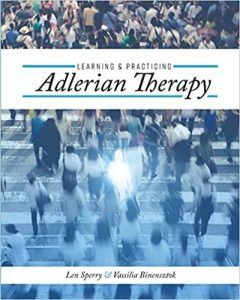22 Most Effective Adlerian Therapy Techniques and Worksheets
 Alfred Adler, a pivotal figure in the early development of psychotherapy, saw the importance of personal choice, cooperation, and connectedness in overcoming difficulties and making positive life changes (Carlson & Englar-Carlson, 2017).
Alfred Adler, a pivotal figure in the early development of psychotherapy, saw the importance of personal choice, cooperation, and connectedness in overcoming difficulties and making positive life changes (Carlson & Englar-Carlson, 2017).
Despite their age, Adler’s ideas remain as relevant as ever and in line with modern views that social relationships and self-actualization are crucial to human growth and wellness.
Adlerian therapy identifies human behavior as goal oriented and socially embedded and recognizes the importance of family groups (Sweeney, 2009).
This article explores Adlerian therapy and several techniques and tools that help people move forward in their lives.
Before you continue, we thought you might like to download our three Positive Psychology Exercises for free. These science-based exercises explore fundamental aspects of positive psychology, including strengths, values, and self-compassion, and will give you the tools to enhance the wellbeing of your clients, students, or employees.
This Article Contains:
- What Is Adlerian Therapy? 10 Theoretical Principles
- 15+ Key Concepts & Goals of Adlerian Therapy
- Adlerian Therapy in Practice: 2 Examples
- How Does It Work? 10+ Techniques and Interventions
- 9 Worksheets, Activities, and Questions to Ask
- A Look at Adlerian Group Therapy Techniques
- 6 Limitations and Strengths of the Approach
- Training in Adlerian Therapy: 3 Opportunities
- 3 Fascinating Books on the Topic
- Resources From PositivePsychology.com
- A Take-Home Message
- References
What Is Adlerian Therapy? 10 Theoretical Principles
“Along with Freud and Jung, Alfred Adler was a major contributor to the initial development of the psychodynamic approach to therapy” (Corey, 2013, p. 102). After collaborating for 10 years, Adler deviated from Freud’s biological and deterministic point of view (which he believed was excessively narrow) to a social-psychological or goal-oriented view of human nature.
Crucially, “Adler envisioned a psychology of growth, where people could strive to overcome difficulties and actually change their lives” (Carlson & Englar-Carlson, 2017, p. 4).
The following points summarize some of the key theoretical principles of what became Adlerian therapy (modified from Sommers-Flanagan & Sommers-Flanagan, 2015):
- Holism
Humans must be treated as a single unit rather than divided into separate parts. - Superiority striving
Despite obstacles, we naturally strive (actively and creatively) toward excellence and task completion. - Purpose
Humans work toward specific goals in life, driven by future hopes rather than past experiences. - Social interest and community feeling
We strive to connect socially at an individual and community level. The absence of community would lead to arrogance and selfishness. - An idiographic approach
While generalizations can be helpful, every human must be considered unique. - Phenomenology
Everyone creates their own reality; experiences are based on individual perceptions and subjectivity. - Soft determinism
Biology and environment influence, but do not determine, behavior. - Freedom to choose
We are responsible for choosing our behavior from a limited number of options. Yet, we often make poor choices because of a lack of knowledge or education. - Lifestyle
The schemas used for directing ourselves through our lives are established during childhood but can be changed later through education and therapy. - Optimism
Adler was “hopeful that the pull toward social interest and community feeling and the drive toward completeness would help individuals live together peacefully and happily” (Sommers-Flanagan & Sommers-Flanagan, 2015, p. 88).
In summary, Adlerian therapy sees the individual as motivated by social relatedness, purpose, goals, and consciousness (Corey, 2013).
15+ Key Concepts & Goals of Adlerian Therapy

- Building mutual respect
- Performing a lifestyle assessment
- Identifying and disclosing faulty assumptions (mistaken goals) in the client’s lifestyle
- Reorientation of the client toward a more meaningful lifestyle
Adlerian therapy aims to develop “the client’s sense of belonging and to assist in the adoption of behaviors and processes characterized by community feeling and social interest” (Corey, 2013, p. 109).
The client is not considered sick or in need of healing. Instead, the therapist seeks to reeducate them and, where possible, reshape society. For the client to find a way of living with social interest, they must be given a new “cognitive map” – an alternative way of looking at themselves and the world around them.
The goals of Adlerian therapy are therefore educational, helping clients to (modified from Corey, 2013):
- Foster and grow social interest
- Overcome feelings of inferiority and discouragement
- Change their lifestyle by modifying their views and goals
- Challenge faulty motivation
- Recognize equality among people
- Become contributing members of society
Adlerian therapy is not only centered on the individual. Treatment recognizes the demands placed on the client by the world as six interrelated life challenges (Sommers-Flanagan & Sommers-Flanagan, 2015):
- Work or occupation
Individuals must be able to work cooperatively through social relationships. - Social relationships
Establishing strong and healthy relationships is a vital outcome of therapy. - Love and marriage
Lifestyle changes, developing empathy, and thinking and acting to benefit relationships are also goals of Adlerian therapy. - Self
Our relationship with ourselves is formed during childhood but can be improved through good self-care and a reasonably positive yet accurate opinion of ourselves. - Spirituality
It is important and helpful to have a good understanding of our relationship with God, religion, and the universe. - Parenting and family
Family and parenting are essential life tasks and extensions of love and marriage.
Adlerian Therapy in Practice: 2 Examples
Adlerian therapy works with clients facing real problems; they require support and new ways of thinking, along with clearly defined goals (Corey, 2013; Sommers-Flanagan & Sommers-Flanagan, 2015).
Case example 1: Spoiled rich kid
Sommers-Flanagan and Sommers-Flanagan (2015, p. 102) used an image to challenge a 15-year-old boy who persistently criticized his mother’s wealth while complaining he had an insufficient allowance: “I had an image of a closet spoiled rich kid. You want money […], but you’re uncomfortable with your friends seeing you as rich.”
The new insights offered by the image helped the boy connect and share his inner conflicts and beliefs about money and his lifestyle, benefitting his treatment.
Case example 2: Stan
In another case, the therapist resisted choosing his client’s (Stan) goals and instead adopted a more collaborative approach (Corey, 2013). The therapist began by using an assessment to explore his relationships, roles, and feelings about himself. The results, along with ongoing conversations, uncovered that Stan felt he would get hurt if he got close to people and would only be acknowledged if he became perfect.
During the reorientation phase, the client and therapist reflected on alternative beliefs, attitudes, and actions. Stan was helped to accept that he needn’t remain a victim and could, instead, take control of life.
How Does It Work? 10+ Techniques and Interventions

Through collaboration, the therapist can help the client (Sweeney, 2009):
- Learn about mistake goals
- Find the motivation to change
- Replace unhelpful private logic with common sense
- Develop more social interest as they change
- Feel a sense of belonging and equality with others
- Become brave enough to take risks
Typically, Adlerian therapy is broken down into several stages, with appropriate techniques and interventions for each one (Sommers-Flanagan & Sommers-Flanagan, 2015):
Forming the therapeutic relationship
The therapeutic relationship is formed through effective listening and caring. The therapist is eager to “foster collaboration and communicate interest in the client as a person” (Sommers-Flanagan & Sommers-Flanagan, 2015, p. 93).
Goal alignment
The therapist works hard to identify and understand the client, their needs, and their goals for therapy.
Focusing on positives and avoiding pathologizing
The therapist must focus on strengths and problems equally, showing interest in the whole person rather than someone who needs to be “cured.”
Lifestyle assessment and analysis
An evaluation of the client’s lifestyle is an important part of treatment, typically using one of the following three interview formats (Sommers-Flanagan & Sommers-Flanagan, 2015):
- Family constellation interview
Used to find out relevant information about childhood experiences, including describing family members, their interactions, and childbirth order. - ‘The Question’
Used to uncover the purpose of the client’s symptoms, such as “How might your life differ if you were well?” - Earliest recollections
Rather than reflecting on the past, the “earliest recollections” questions are there to forecast the future. For example, “Is the individual giving or taking? Alone or with others? What emotion do they use?”
Interpretation and insight
Therapy must uncover the connections between insight, motivation, and action. Adlerian therapists work collaboratively with the client, asking questions (such as, “Could this be true?”) to deepen their understanding.
Reorientation
Insight gives way to action through directly applying specific techniques to facilitate change; for example:
- The future autobiography
The client is asked to write a story about how the rest of their life might look. - Creating new images
Analyzing the client’s early recollections and basic mistakes makes it possible to produce a new visual positive image to replace a more negative one. - Acting as if
Clients may wish for traits they don’t currently possess. The therapist can prompt them to act as if they do have them by asking clients, “How would it look if you had X?” (for example, more confidence or assertiveness).
9 Worksheets, Activities, and Questions to Ask
Understanding the client’s past can help predict their future (Sommers-Flanagan & Sommers-Flanagan, 2015).
The following worksheets and therapy questions are helpful.
Understanding Siblings
The Understanding Siblings worksheet helps gain insight into the family relationships formed during childhood and an understanding of how birth order may have affected beliefs and behavior (Sommers-Flanagan & Sommers-Flanagan, 2015).
Follow-up questions dig a little deeper, such as:
Who took care of each other?
Who played with each other?
Who was most like you?
Who was least like you?
Catching Oneself
The Catching Oneself worksheet is used for reflection purposes to help the client recognize when they act or think in ways that lead to angry outbursts or a loss of control (Sommers-Flanagan & Sommers-Flanagan, 2015).
Ask the client to think of times over the last week when they became angry or had an outburst.
When was it? What happened?
Has this happened before?
What typically triggers this sort of outburst?
What could you do to reduce the likelihood of it happening or its severity?
By better identifying when outbursts occur and why, they will become more able to avoid the situation or control their feelings.
Reflecting As If
The Reflecting As If intervention can help change behaviors (Sommers-Flanagan & Sommers-Flanagan, 2015).
The client is asked:
- How would it look if you were watching yourself on video acting in the way you would like to?
- What would be the first signs that you had begun to act in that way?
Sample Adlerian questions
The following six questions are typical ones used in Adlerian therapy (modified from Carlson et al., 2006):
What brings you to see me today?
What kind of person would you like to be in six months?
How would you like things to be in a year?
What would your life be like if you didn’t have this problem?
Of the problems you have shared today, which is most upsetting or troubling for you?
What would need to happen for the work to be nearing completion?
A Look at Adlerian Group Therapy Techniques

However, as with all group therapy, there are a few points that deserve early consideration, including (Sonstegard & Bitter, 2004):
- How many people can the therapist be fully engaged with for an hour or more?
- Find a well-lit, private space, free from distractions that comfortably fits the size of the group.
- What is the balance of gender, age, and culture?
The following three Adlerian techniques have proven successful in group settings:
- Group agreements
Having introduced one another, it is helpful for group members to determine a set of guidelines regarding what is acceptable; this may include how long to meet and how to ensure psychological and personal safety. - “The question”
Asking questions, such as, “What would you be doing if these symptoms or problems were removed?” can open up discussion and dialogue in the group. Hearing other members’ successes (even imagined ones), difficulties, and concerns can create a safe space. - Family constellation
The clients discuss the major influences in their life and how they shaped their interpretation of life and society.
6 Limitations and Strengths of the Approach
The Adlerian approach has had a profound and long-term effect on therapy and has both strengths and limitations (Corey, 2013; Sommers-Flanagan & Sommers-Flanagan, 2015).
Strengths
- Adlerian therapy is typically sensitive to the needs of the client but requires rigorous training.
- The belief that clients are not psychologically sick but need help with mistaken beliefs is in line with many modern therapeutic approaches.
- Therapy techniques offer therapists considerable freedom in working with clients.
Weaknesses
- Changing the autonomous self may be culturally at odds with some clients and their beliefs.
- Clients from some cultures may not be interested in exploring their past as a child and wish to see the counselor as the “expert.”
- Clients may find it difficult or even inappropriate to share family struggles.
While there may be challenges, “the therapeutic approach allows for the use of a variety of relational, cognitive, behavioral, emotive, and experiential techniques” (Corey, 2013, p. 127).
Training in Adlerian Therapy: 3 Opportunities
While there are many face-to-face and online training options, we have chosen to share three below.
Adler Graduate School
The Adler Graduate School provides master’s degrees and certification in Adler’s techniques and approach to therapy.
Academic study is teamed with counseling internships for experiential learning.
Positive Discipline Association

While they don’t come with a certification for practicing psychotherapy, the four sessions offer useful insight into its underlying principles.
Bucks Adlerian Training
This UK-based training offers a diploma in Adlerian counseling as part of its advanced certificate in the theory of individual psychology and Adlerian counseling skills and includes 100–120 hours of supervised client counseling.
3 Fascinating Books on the Topic
While many therapy books introduce Adlerian therapy techniques (among other therapeutic approaches), the following three books are dedicated to the topic.
1. Learning and Practicing Adlerian Therapy – Len Sperry and Vassilia Binensztok
The authors offer a substantial review of conventional Adlerian therapy and introduce a more contemporary version – Adlerian pattern-focused therapy.
This is an ideal resource for future clinicians to gain a theoretical and practical understanding of the benefits of Adlerian therapy.
Find the book on Amazon.
2. Adlerian Counseling and Psychotherapy: A Practitioner’s Wellness Approach Therapy – Thomas Sweeney
Now in its sixth edition, this book from Thomas Sweeney takes the reader through a scholarly and thought-provoking analysis of Adlerian therapy.
The book’s clear and engaging style provides a solid explanation of theory and practice in a user-friendly format.
Find the book on Amazon.
3. Adlerian Psychotherapy – Jon Carlson and Matt Englar-Carlson
This introduction to the theory, history, and practice of Adlerian psychotherapy brings the importance of Adler’s approaches into the reader’s view.
It is a valuable book for those wishing to understand the importance and far-reaching impact of Adlerian therapy and its potential in short-term therapeutic approaches.
Find the book on Amazon.
Resources From PositivePsychology.com
We have many resources available for mental health professionals providing support to clients seeking help in therapy sessions.
Free resources include:
- Setting Valued Goals
Reflect on personal values and why they matter to determine your most important goals. - What I See in You
Practice performing positive self-appraisal in a group setting. - Positive Memories of Childhood
Reflect on positive memories and emotions from childhood.
More extensive versions of the following tools are available with a subscription to the Positive Psychology Toolkit©, but they are described briefly below:
- The Self-Compassion Miracle Question
Clients are asked to imagine that they no longer talk to themselves in a negative, self-critical way; instead, they treat themselves with kindness and compassion. - Readiness to Change Assessment
This tool assesses the client’s readiness to change using the transtheoretical model of change.- Step one – Understand the client’s current situation.
- Step two – Perform the readiness to change assessment.
- Step three – Identify the stage of change.
This provides a helpful model for recognizing where the client is with their change and what may be needed to move them forward.
If you’re looking for more science-based ways to help others enhance their wellbeing, check out this signature collection of 17 validated positive psychology tools for practitioners. Use them to help others flourish and thrive.
A Take-Home Message
Alfred Adler recognized that no one exists outside of the society they find themselves in and the importance of social relations (Sweeney, 2009). Indeed, “he valued the role of cooperation with and connectedness to the world around each person,” including their families (Carlson & Englar-Carlson, 2017, p. 3).
Rather than focusing on the past, Adlerian therapy highlights the importance of goals for positively influencing behavior. Treatment recognizes that the future is built on the now.
Equally importantly, humans are treated as a whole, rather than separate parts, as they strive toward goals and excellence. Each person must be seen as unique; their subjectivity is their own, and they have the freedom to choose how they live.
Adlerian therapy can help clients who become stuck by disclosing unhelpful assumptions and reorienting the client toward more meaningful styles of living.
While Adlerian therapy is less commonplace now, its legacy lives on in the therapeutic techniques that followed. As a result, lessons are still to be learned from this and other early approaches to psychotherapy.
We hope you enjoyed reading this article. Don’t forget to download our three Positive Psychology Exercises for free.
- Carlson, J., Watts, R. E., & Maniacci, M. P. (2006). Adlerian therapy: Theory and practice. APA Books.
- Carlson, J., & Englar-Carlson, M. (2017). Adlerian psychotherapy. American Psychological Association.
- Corey, G. (2013). Theory and practice of counseling and psychotherapy. Cengage.
- Sonstegard, M. A., & Bitter, J. R. (2004). Adlerian group counselling and therapy: Step by step. Routledge.
- Sommers-Flanagan, J., & Sommers-Flanagan, R. (2015). Study guide for counseling and psychotherapy theories in context and practice: Skills, strategies, and techniques (2nd ed.). Wiley.
- Sperry, L., & Binensztok, V. (2018). Learning and practicing Adlerian therapy. Cognella Academic Publishing.
- Sweeney, T. J. (2009). Adlerian counseling and psychotherapy: A practitioner’s approach. Routledge.
Let us know your thoughts
Read other articles by their category
- Body & Brain (49)
- Coaching & Application (57)
- Compassion (26)
- Counseling (51)
- Emotional Intelligence (24)
- Gratitude (18)
- Grief & Bereavement (21)
- Happiness & SWB (40)
- Meaning & Values (26)
- Meditation (20)
- Mindfulness (45)
- Motivation & Goals (45)
- Optimism & Mindset (34)
- Positive CBT (28)
- Positive Communication (20)
- Positive Education (47)
- Positive Emotions (32)
- Positive Leadership (18)
- Positive Parenting (4)
- Positive Psychology (33)
- Positive Workplace (37)
- Productivity (16)
- Relationships (46)
- Resilience & Coping (36)
- Self Awareness (21)
- Self Esteem (38)
- Strengths & Virtues (32)
- Stress & Burnout Prevention (34)
- Theory & Books (46)
- Therapy Exercises (37)
- Types of Therapy (64)









What our readers think
I deeply value the information in this article. It helps in my research work.